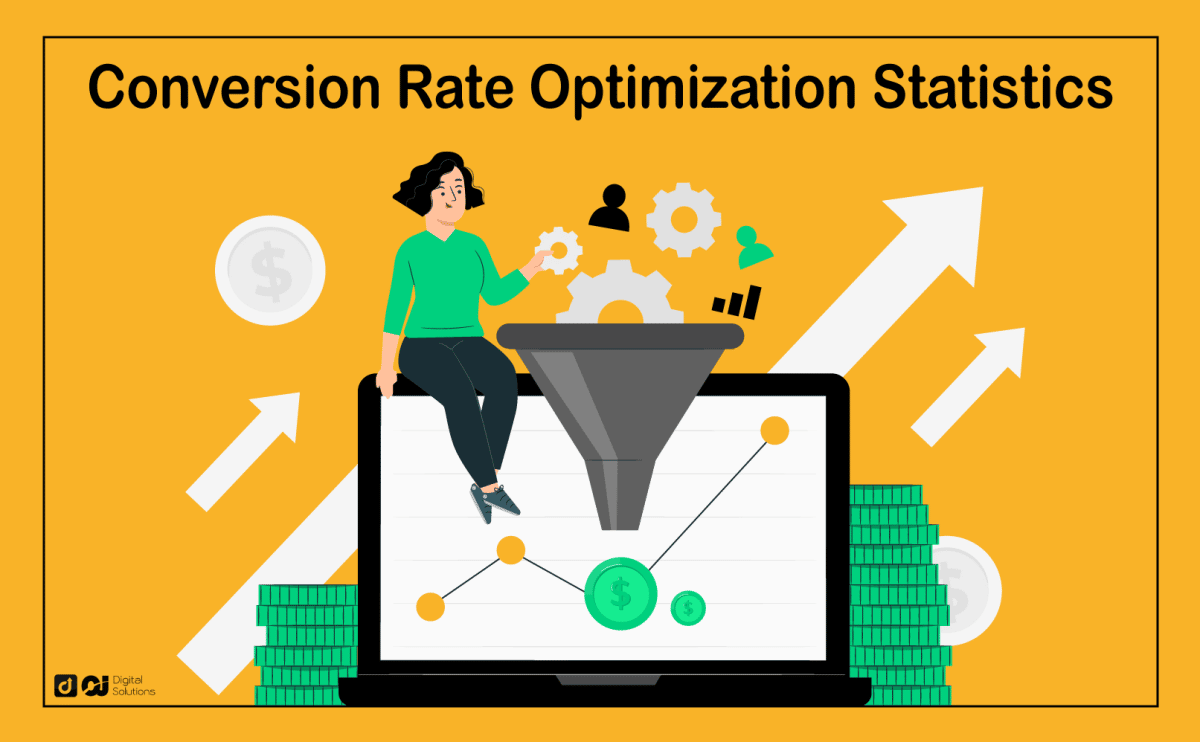In any field, statistics help managers and those in leadership positions see problem areas, determine appropriate courses of action, and monitor progress.
Ecommerce is no different.
Learning conversion rate optimization statistics is essential if you’re an ecommerce business owner or online seller.
If you don’t know where to start, you’ve come to the right place.
I’ve compiled several conversion rate optimization statistics to give you a deeper insight into conversion rates and how they affect businesses.
Let’s start.
What Is Conversion Rate Optimization?
Conversion means a visitor has achieved a specific goal on your website, whether signing up for your newsletter, submitting a form, or purchasing an item. Visitors who’ve completed such actions have “converted.”
Conversion rate optimization (CRO) means increasing conversions on your website. When you increase conversions, more visitors take action.
You can implement many CRO strategies to improve the average conversion rate on your website.
High-quality, well-designed landing pages are critical to improving your conversion rate is to make a good landing page.
User-generated content can boost your conversion rates and establish customer trust.
How Do You Calculate Your Conversion Rate?
Knowing your conversion rate is vital and helps with conversion rate optimization.
Here is how to compute for Conversion rate:
Conversion rate = (Number of conversions ÷ Total visitors) x 100
The CRO statistics I discuss later in the article will help you better understand the elements affecting conversion rate optimization.
Landing Page Conversion Rate
The landing page conversion rate refers to the number of visitors who converted.
You can boost conversions through A/B landing page testing.
Test various aspects of your landing pages to determine which ones negatively affect conversions. Once you know which elements decrease or prevent conversions, you can optimize them.
Conversion Rate Optimization Statistics
Here are critical conversion rate optimization statistics that will give insight into conversion rates across the entire ecommerce world.
The Average Conversion Rate for Websites Is 2.35%.
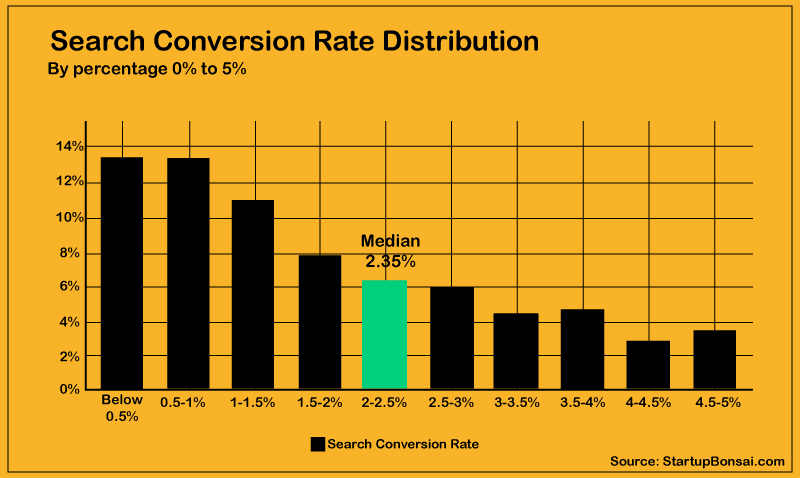
CRO statistics show that the average conversion rate across all industries is 2.35%.
The average conversion rate doesn’t mean the most effective conversion rate.
Conversion rate statistics across different industries vary.
Some industries have higher conversion rates than others.
If your conversion rate is at 2 to 3%, you achieve the average website conversion rate. Anything above 3% is above average.
The Top Websites Have an Average Conversion Rate of at Least 11%.
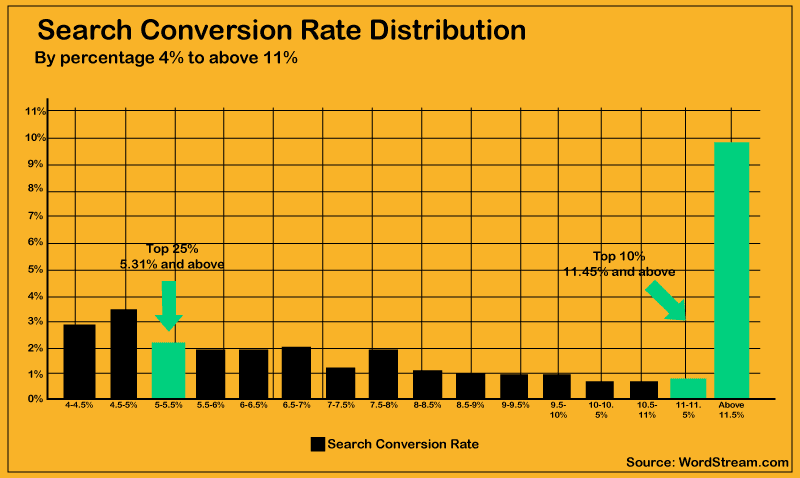
The highest-converting websites (the top 10) have an average website conversion rate of at least 11%.
Some professionals will tell you to focus on your landing pages. However, increasing landing page conversion rates alone won’t get you past the 10% mark.
You must do more, including mobile-optimizing landing pages.
Conversion rate optimization involves tons of testing.
Experiment outside your landing pages to improve your conversion rates.
The Average Conversion Rate for Mobile Devices Is Around 1.53%.
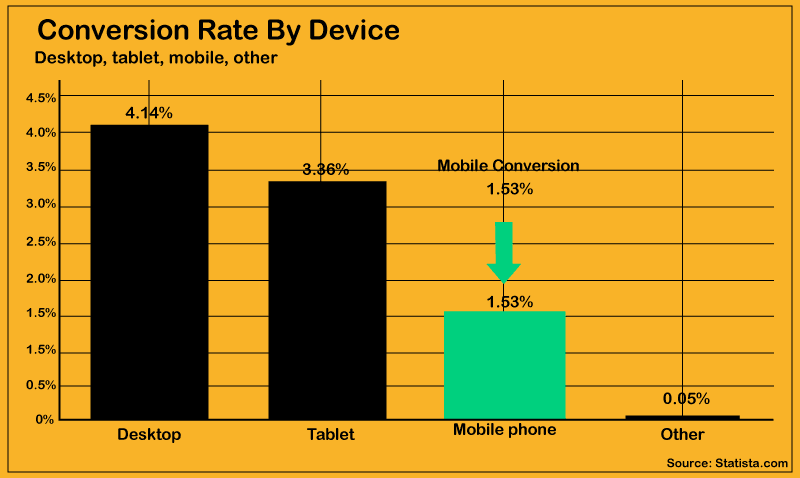
While mobile-optimizing landing pages is crucial, doing so won’t increase your overall conversion rate.
Mobile phone conversion rates have the lowest average conversion rate compared to desktop and tablet conversion rates.
Conversion rate statistics show that landing pages on mobile often are at a disadvantage.
The problem with mobile is that you have to minimize all landing page elements, including text, images, and other functions.
You also have to SEO-optimize your mobile landing pages. Improving your search engine optimization efforts helps you rank higher on Google and gets your landing pages in front of more visitors.
The Average Conversion Rate on Desktop Devices Is 4.14%.
Conversion rate statistics show that the most critical landing page is on your desktop because desktop (or laptop) landing pages tend to have the highest conversion rates.
Better landing pages for desktop devices means improved conversion rate optimization.
Unlike mobile, there is a lot you can do on your desktop.
Desktops have larger screens than mobile devices, making it easier to enhance your landing pages.
Conversion rate optimization is more than just numbers. You also need creativity to make a good landing page.
Creating high-converting landing pages requires balancing optimization and art.
Facebook Ads Have a 9.21% Average Conversion Optimization Rate.
Facebook conversion rate optimization stats show that the average across all industries is 9.21%.
Some industries have better conversion rate optimization than others.
Here’s how Facebook Ad conversion rates vary by industry.
The retail industry is a good example, with 14.29% conversion optimization compared to the fitness industry at just 3.26%.
Here are the Facebook conversion rate optimization stats:
- Retail industry – 14.29
- Apparel Industry – 4.11%
- Auto Industry – 5.11%
- B2B Industry – 10.63%
- Beauty Industry – 7.10%
- Customer Service Industry – 9.96%
- Education Industry – 13.58%
- Employment and Job Training Industry – 11.73%
- Finance and Insurance Industry – 9.09%
- Fitness Industry – 14.29%
- Home Improvement Industry – 6.56%
- Healthcare Industry – 11.00%
- Industrial Services Industry – 5.60%
- Legal Industry – 3.64%
- Real Estate Industry – 10.68%
- Retail Industry – 3.26%
- Technology Industry – 2.31%
- Travel and Hospitality Industry – 2.28%
The Sporting Goods Industry Has the Lowest Ecommerce Conversion Rate at 2.35%.
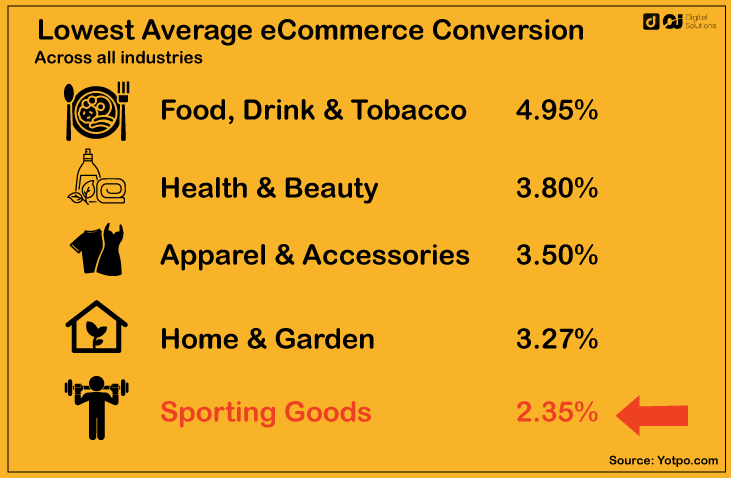
The sporting goods industry’s ecommerce conversion rate is only 2.35%. Conversion rate optimization in this industry is challenging but not impossible.
Focus on high-ticket items to make up for the larger ad spend.
One reason for low CRO statistics for sporting goods is the customer mindset. When it comes to sporting goods, some customers prefer getting them instantly.
Many buyers prefer to purchase in-store and touch or test the goods before buying them.
The Food and Beverage Industry Has the Highest eCommerce Conversion at 4.95%.
CRO statistics show the food and beverage industry has the highest conversion optimization rates due to the psychology behind the food.
Buyers purchase food every day. People need to eat, after all.
The question is what food to buy, and it’s where a good landing page fits in.
You can boost conversions by improving your method of displaying products on your website and using high-quality images.
The Professional and Financial Services Industry Has the Highest Average B2B Conversion Rate at 10%.

Conversion rate optimization stats show multiple professional/financial service landing pages have high conversion rates, often due to marketing strategies.
This industry regularly promotes financial services that help customers earn. CRO statistics show customers are likelier to click through if they think they can benefit.
Marketers implement digital marketing campaigns and package products to promote customer benefits, improving conversions.
Another reason for this industry’s excellent CRO statistics is they use multiple customer acquisition channels.
The Nonprofit Industry Has the Lowest B2B Average Conversion Rate at 2.00%.
CRO statistics show that nonprofits with conversion rates the most, likely due to their industry’s nature.
Most landing pages showcase products and highlight customer benefits.
Nonprofits show how customers can give. This approach naturally makes it harder to get more conversions.
Non-profits need competitive CRO strategies to reach more people and increase conversion rates.
Another thing non-profits can do is to avoid long-form landing pages. A landing page must be direct and appealing to improve landing page conversions.
Paid Search Has the Highest Average Conversion Rate by Traffic Source at 2.90%.
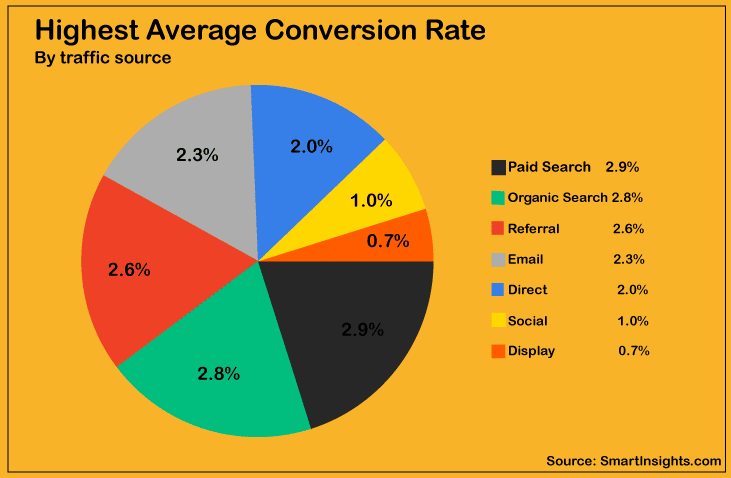
In some industries, four to ten contacts are from paid search strategies. The maximum percentage of organic searches is 2.8%, 0.1% less than paid searches.
Sometimes, the best way to generate web traffic is through ads.
Companies Spend $1 on CRO for Every $92 Spent on Customer Acquisition.
Many businesses invest far more in customer acquisition than conversion. Companies spend $1 on conversion for every $92 they spend on customer acquisition.
This statistic means businesses spend more money increasing traffic than converting it.
Traffic is useless unless you turn it into conversions.
You can follow documented CRO strategy samples to see how businesses manage acquisitions versus conversions.
There has to be a healthy balance of both, but it also depends on the industry.
Some industries have naturally low conversion rates, so businesses focus more on acquisition.
Inherently low conversion rates don’t mean you should abandon conversions. You just have to be intelligent about spending your resources.
High-converting Businesses Understand the Importance of CRO.
Companies with high conversions spend at least 5% of their budget on CRO, meaning they know the importance of conversion.
Businesses that focus on ads tend to forget the basics, including building mobile-optimized sites, designing multiple landing pages, and improving the experience of website visitors.
You can get more conversions by knowing your target audience and how to reach them.
55.5% Of Companies Want To Increase Their CRO Budget.
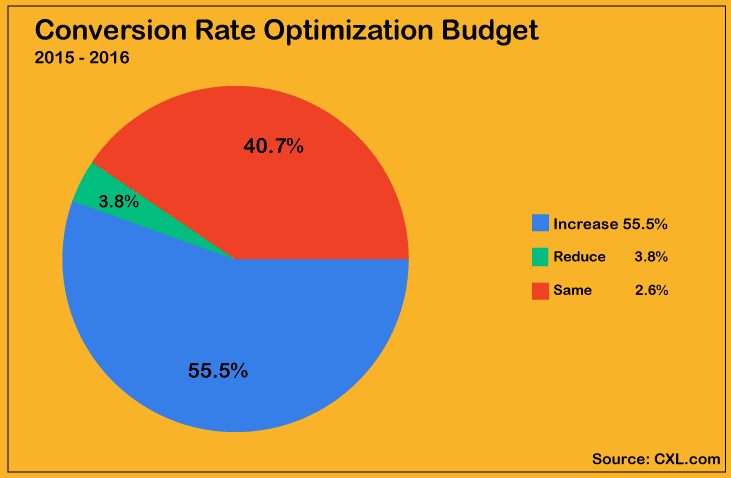
Companies are learning that conversions are as essential as advertising.
Many organizations mistakenly focus only on advertising, launching multiple campaigns that don’t effectively translate to purchases.
Companies Spend an Average of $2,000 on CRO Tools.
Increasing the conversion rate is an investment, and the tools that help increase conversions can be expensive.
Companies spend an average of $2,000 on CRO tools.
Suppose you have 10,000 visitors, and 100 made a $20 purchase. You get a gross revenue of $2,000.
If you invest in a tool that increases conversions to 300 who made a $20 purchase, your gross revenue is $6,000. This number is $4,000 higher than if you never purchased the tool.
If the tools cost $2,000, your net profit would be $2,000 (minus other expenses).
While oversimplified, the above example illustrates why companies are willing to invest in expensive CRO tools.
It’s Rare for Companies To Have a Solid CRO Strategy.
Only one-third of businesses have structured CRO strategies.
Your CRO strategy should be streamlined, effective, and measurable.
A good CRO strategy is a numbers game. You should know how much you spend and how much it affects your business.
Scaling From 10 Landing Pages to 15 Increases Leads by 55%.
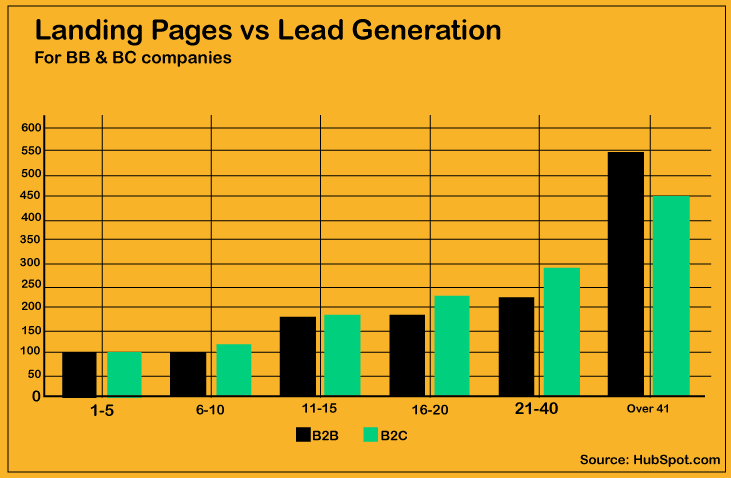
Companies with more landing pages tend to convert more traffic to leads.
Statistics show that the more campaigns you launch, the higher your chance of conversions.
Perform tests to find the most effective campaigns, like launching two similar campaigns for different audiences.
Keep doing what worlds, but never stop innovating.
The best results come from innovation and scaling. Take advantage of your best strategies and scale them once you see positive results.
Websites With Over 40 Landing Pages Generate 12 Times More Leads.
More landing pages mean higher conversion rates, which is evident in websites with over 40 landing pages.
Websites with over 40 landing pages tend to generate 12 times more leads than websites with only one to six landing pages.
The increased number of leads is due to the websites being more diverse and having significantly more content.
However, you still have to make well-designed landing pages rather than random ones just to increase the number of landing pages on your site.
Almost a Third of Businesses Have Less Than Six Landing Pages.
62% of businesses have only six or fewer landing pages.
Most businesses only know about advertising and not conversion. They aren’t familiar with the benefits of having more landing pages.
If you have an in-house web designer and developer, you can make more landing pages regularly.
Test your landing pages to determine which ones work best.
Once you’ve struck gold, take advantage of your best landing pages to drive conversions.
B2B Clicks Often Go to Home Pages, Not Landing Pages.
44% of B2B clicks go to home pages, not landing pages.
Almost half of B2B clicks go to home pages, meaning more businesses must realize the significance of landing pages.
A homepage is a good overview of your company but doesn’t help with traffic conversion because it’s a mere introduction without context.
A landing page allows you to communicate directly with your visitors. Your landing page is a make-or-break element of the website. If it’s well-designed, people convert. If not, they leave.
“Click Here” Has a Higher Conversion Than “Submit.”
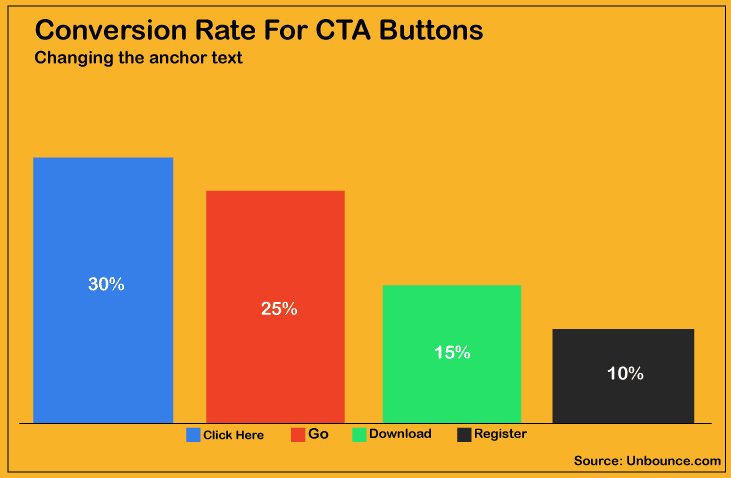
Language plays a huge role in conversion.
Your conversion ability depends on your landing page design and word choice, especially with CTAs.
Using “Submit” on your CTA can decrease your conversion rate by up to 3%, highlighting how word choice can affect conversion rates.
Generally, the more formal your CTAs, the less likely they convert visitors.
However, there is no standard language rule for all businesses. You should use language fitting your market.
Multi-page Forms Are Better Than Single-page Forms.
Multi-page forms have a 13.85% conversion rate. Meanwhile, single-page ones have a conversion rate of 4.53%.
Multi-page forms separate lengthy single-page forms into bite-sized pieces.
If you have 20 questions, it’s better to have four pages of five questions each instead of one long page.
Marketers use the multi-page technique to avoid overwhelming visitors with too many questions.
Furthermore, you should only ask critical questions. Don’t ask questions that have nothing to do with the information you need.
Many people don’t have the tolerance for long forms. Therefore, breaking forms down into multiple pages is more effective.
Requesting a Telephone Number Reduces Conversions by 5%.
Asking for a phone number decreases conversions by 5% because most visitors must trust you first to give you their contact number.
Some people are okay with giving their contact info, but most aren’t.
Instead of asking for their number right away, you can ask for it further down the funnel.
You should wait until visitors trust you before asking for their phone numbers.
Longer Landing Pages Generate Two Times More Leads Than Shorter Ones.
Longer landing pages tend to generate 200% more leads than shorter ones, but it doesn’t mean you should make long landing pages exclusively.
You have to find the perfect balance for your landing pages.
Some websites have long pages only because long landing pages suit their target market.
For example, longer landing pages work more for the finance industry than the fashion industry.
The finance industry needs time to explain information to its audience. Meanwhile, fashion is often self-explanatory. Thus, a long fashion landing page is unnecessary and hurts conversion rates.
The Bottom Line
I hope the CRO statistics in this article gave you insight into what you need to do to get more conversions for your e-commerce business.
Use the information you learned in my article to determine areas for improvement in your conversion optimization strategies.
You should also learn why a website is important to your business and conversion rates.

